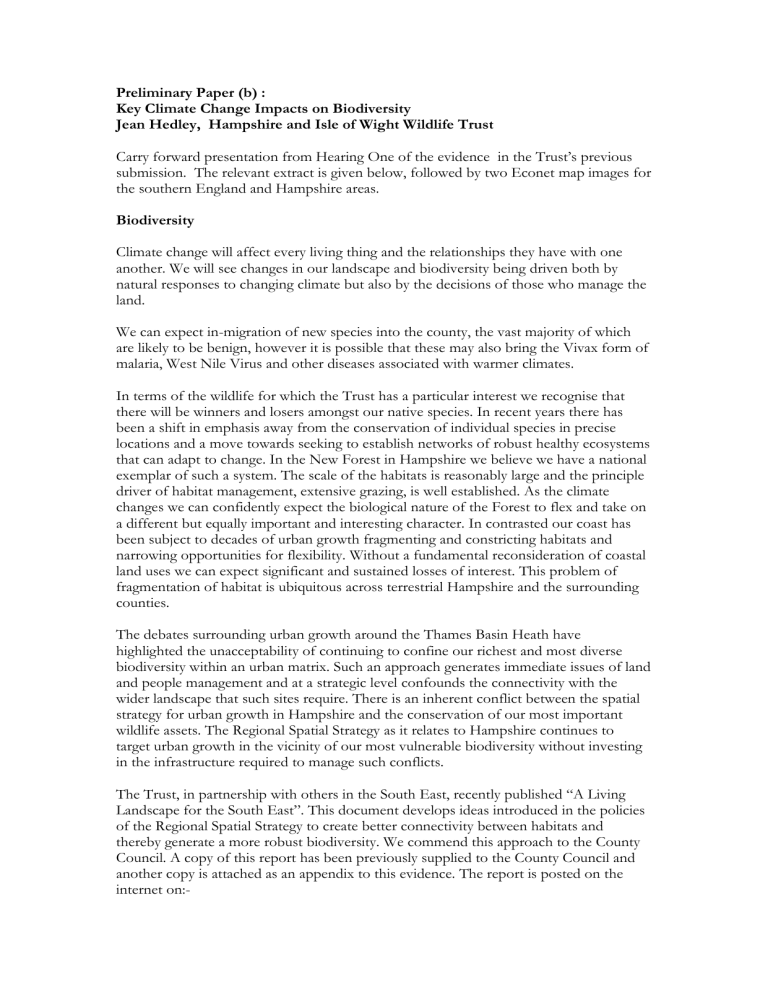Biodiversity - Hampshire County Council

Preliminary Paper (b) :
Key Climate Change Impacts on Biodiversity
Jean Hedley, Hampshire and Isle of Wight Wildlife Trust
Carry forward presentation from Hearing One of the evidence in the Trust’s previous submission. The relevant extract is given below, followed by two Econet map images for the southern England and Hampshire areas.
Biodiversity
Climate change will affect every living thing and the relationships they have with one another. We will see changes in our landscape and biodiversity being driven both by natural responses to changing climate but also by the decisions of those who manage the land.
We can expect in-migration of new species into the county, the vast majority of which are likely to be benign, however it is possible that these may also bring the Vivax form of malaria, West Nile Virus and other diseases associated with warmer climates.
In terms of the wildlife for which the Trust has a particular interest we recognise that there will be winners and losers amongst our native species. In recent years there has been a shift in emphasis away from the conservation of individual species in precise locations and a move towards seeking to establish networks of robust healthy ecosystems that can adapt to change. In the New Forest in Hampshire we believe we have a national exemplar of such a system. The scale of the habitats is reasonably large and the principle driver of habitat management, extensive grazing, is well established. As the climate changes we can confidently expect the biological nature of the Forest to flex and take on a different but equally important and interesting character. In contrasted our coast has been subject to decades of urban growth fragmenting and constricting habitats and narrowing opportunities for flexibility. Without a fundamental reconsideration of coastal land uses we can expect significant and sustained losses of interest. This problem of fragmentation of habitat is ubiquitous across terrestrial Hampshire and the surrounding counties.
The debates surrounding urban growth around the Thames Basin Heath have highlighted the unacceptability of continuing to confine our richest and most diverse biodiversity within an urban matrix. Such an approach generates immediate issues of land and people management and at a strategic level confounds the connectivity with the wider landscape that such sites require. There is an inherent conflict between the spatial strategy for urban growth in Hampshire and the conservation of our most important wildlife assets. The Regional Spatial Strategy as it relates to Hampshire continues to target urban growth in the vicinity of our most vulnerable biodiversity without investing in the infrastructure required to manage such conflicts.
The Trust, in partnership with others in the South East, recently published “A Living
Landscape for the South East”. This document develops ideas introduced in the policies of the Regional Spatial Strategy to create better connectivity between habitats and thereby generate a more robust biodiversity. We commend this approach to the County
Council. A copy of this report has been previously supplied to the County Council and another copy is attached as an appendix to this evidence. The report is posted on the internet on:-
http://www.kentwildlifetrust.org.uk/pdfs/A_Living_Landscape_for_the_South_East.pdf
Econet Map for Hampshire showing the location of important ecological networks.
Econet Map for South East England






